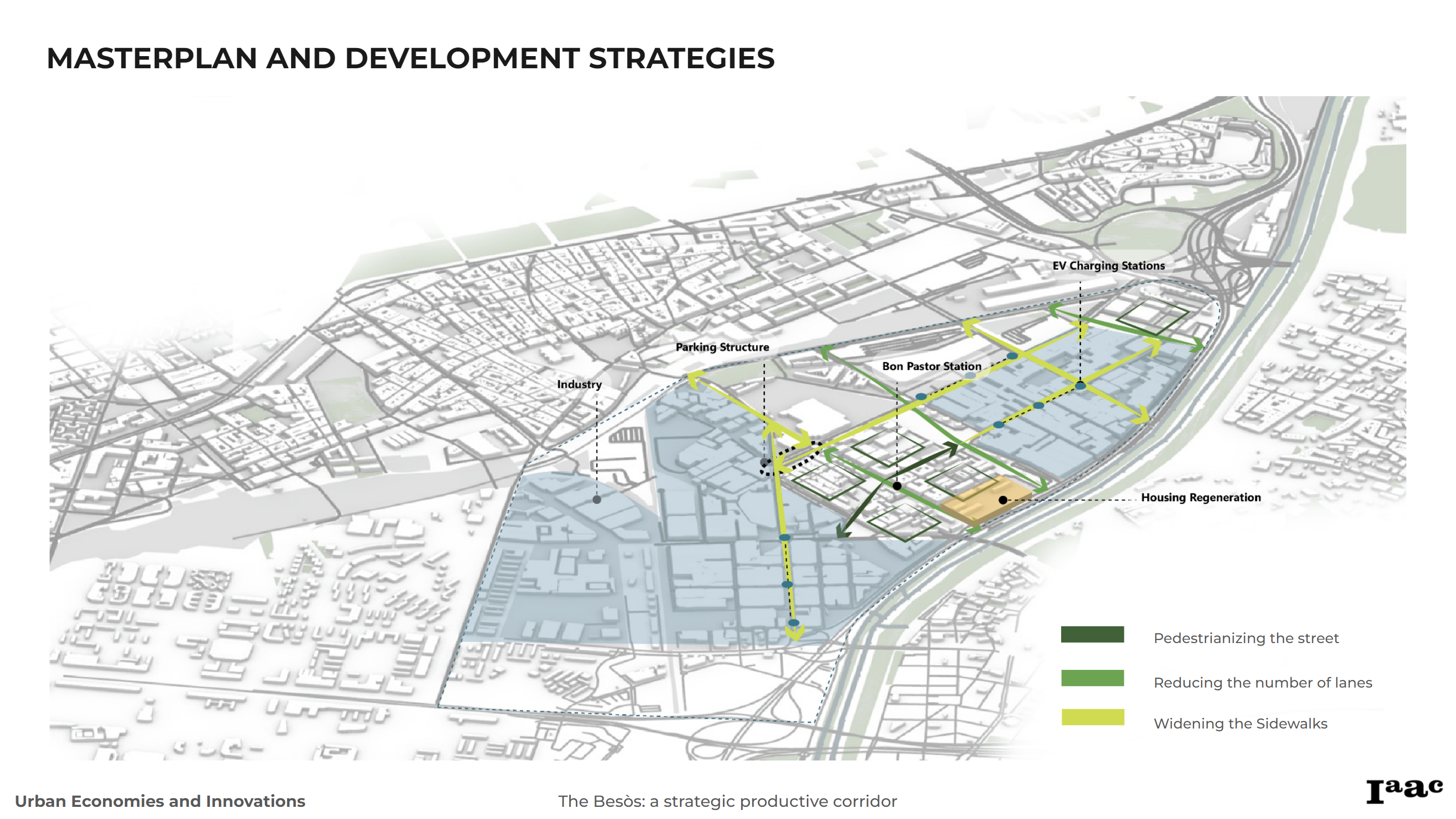Details
INTRODUCTION
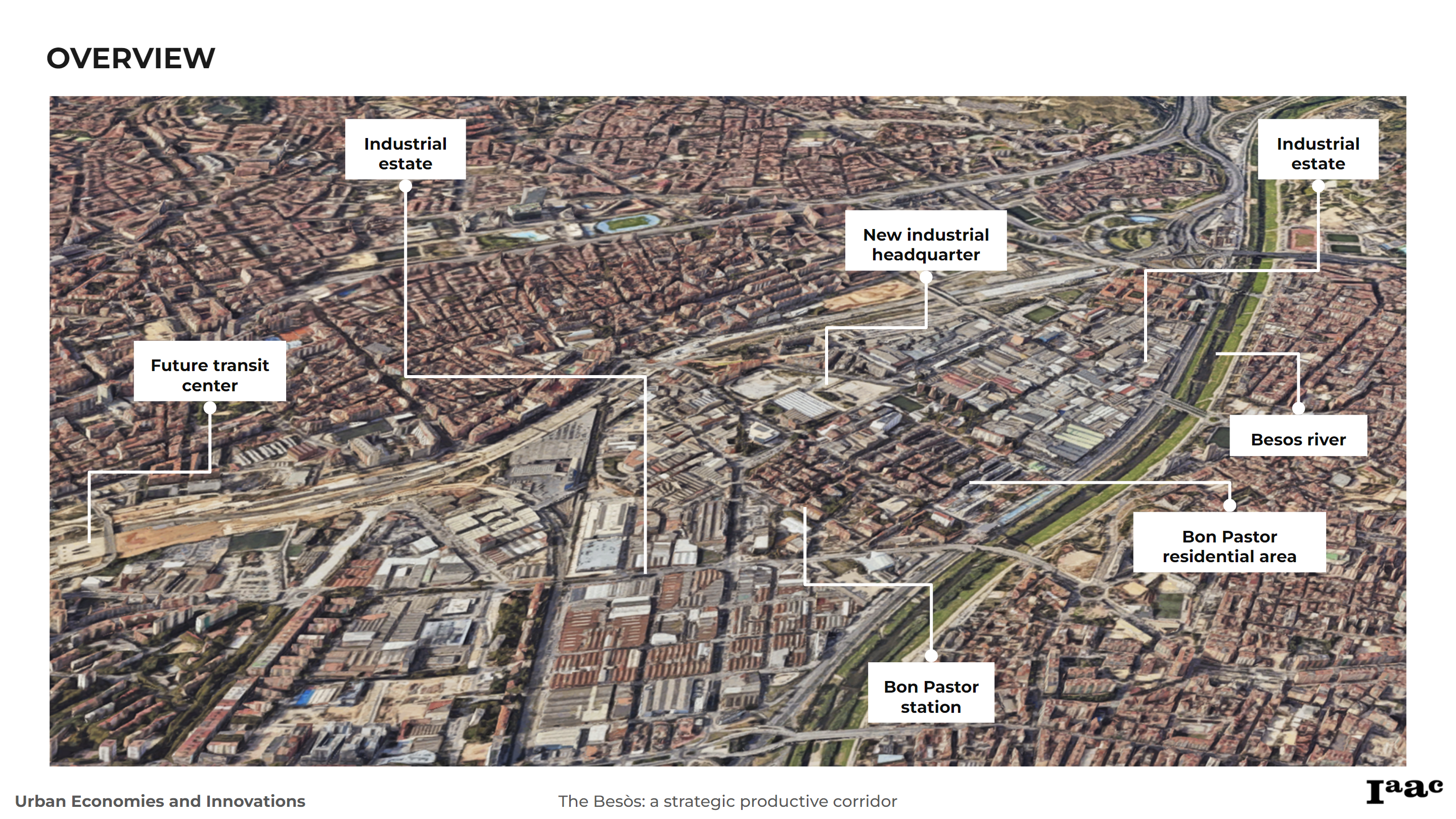
Bon Pastor, situated in the Sant Andreu district along the Besòs River in northeast Barcelona, boasts a profound cultural heritage and a history marked by resilience and resistance. The neighborhood is one of the few pockets of the city where you can still see an example of popular architecture from the early 20th century, historical heritage of the city of Barcelona. The opening of the La Maquinista Shopping Center, the moderation of aging due to immigration and especially the arrival of the metro in 2010 gave an important boost to the neighbourhood.
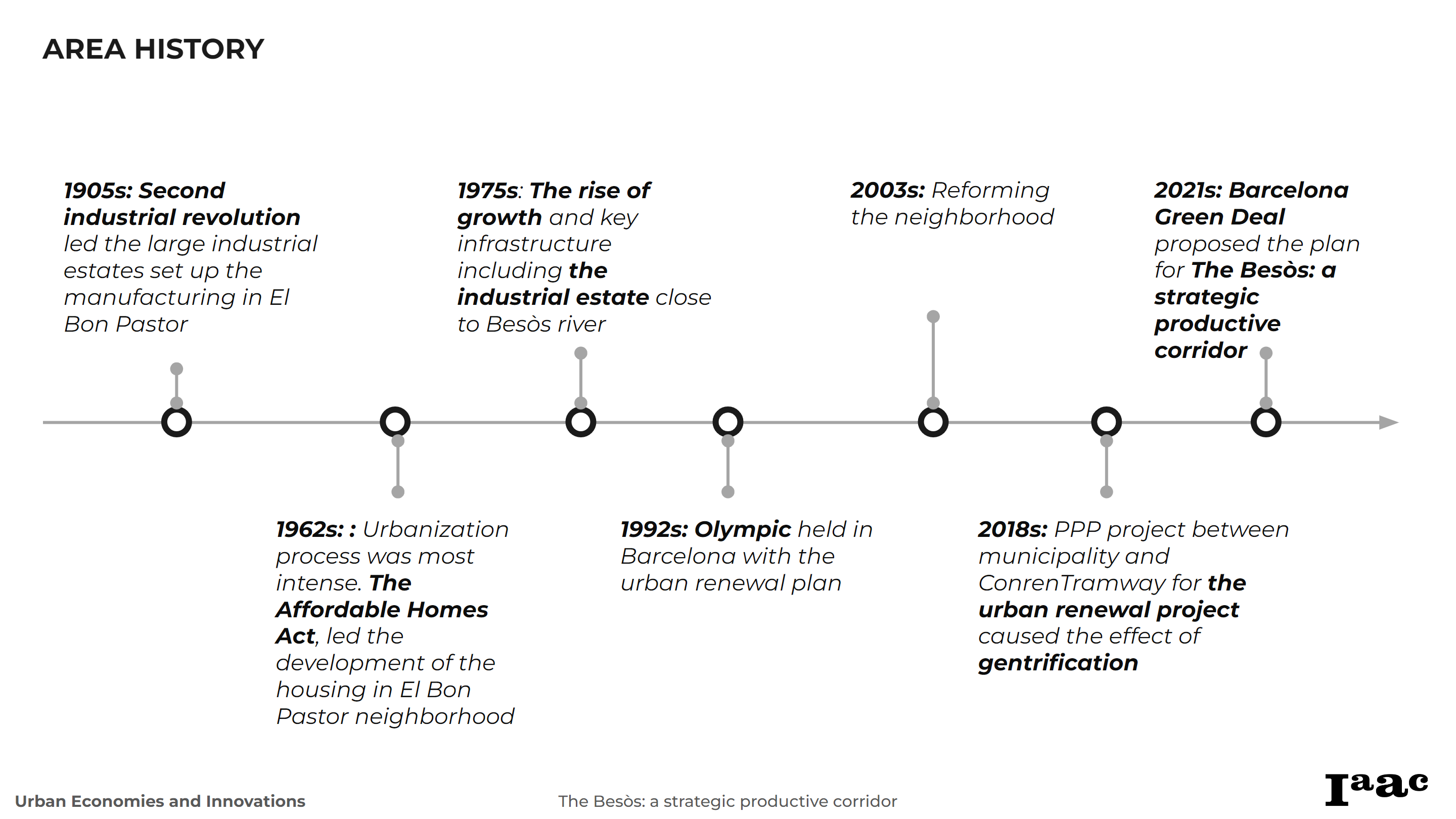
GOVERNMENT PLAN
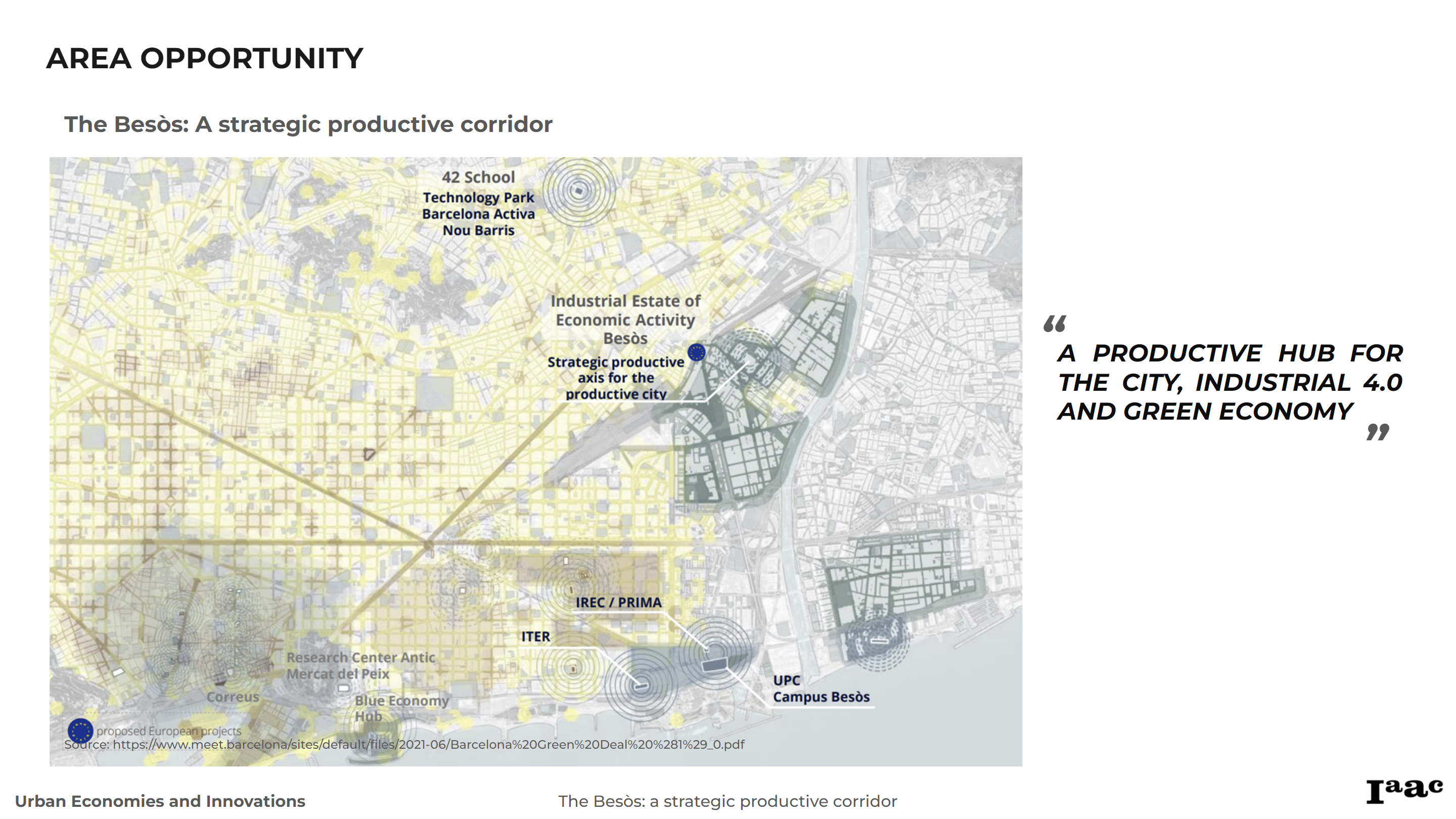
The stretch of land bordering the coastal ring road alongside the Besòs River presents a predominantly industrial setting, prompting a critical reassessment of its future trajectory. Positioned perpendicular to the ring road and in close proximity to the Sagrera station, connected to forthcoming metropolitan developments such as the Tres Xemeneies of the Besòs and the Badalona industrial estates, this area is poised to attain central significance, solidifying its strategic role as a hub for productive activities within the city.
This evolving space holds tremendous potential to accommodate local logistics and activities intricately linked to the city’s metabolic functions. Its expansive plots, both in size and layout, render it uniquely suitable for ventures involving renewable energy, Industry 4.0, or other endeavors demanding ample space not readily available in the city’s compact urban fabric. Thus, we are contemplating the activation of pivotal productive zones, intended, among other objectives, for the deployment of activities crucial to the strategic sectors of the green economy.
ECONOMIC APPROACHES

Strengths:
- Affordable House Prices: El Bon Pastor offers affordable housing. This strength not only attracts a diverse population but also fosters economic inclusivity.
- Proximity to the River: The neighborhood’s proximity to the river is something very unique in Barcelona and also adds potential for recreational spaces, enhancing the overall quality of life for residents.
- Metro/Train Connectivity: With seamless access to public transportation, residents enjoy convenient commuting options, fostering accessibility and connectivity with the rest of the city by metro.
- Big Shopping Mall: A bustling shopping mall within the neighborhood stimulates economic activity, creates job opportunities, and establishes itself as a social hub.
Weaknesses:
- Outdated Industrial Areas: Aging industrial zones pose challenges, both environmental and aesthetic, potentially hindering the overall attractiveness of the neighborhood.
- Isolated Neighborhood: Limited connectivity raises concerns about the flow of people and economic activity, impacting the vibrancy of the community.
- Lack of Services: Insufficient essential services, including healthcare and education, present challenges to residents’ well-being.
- Green Spaces: The absence of green spaces affects the neighbourhood’s liveability, emphasizing the need for areas that promote physical and mental well-being.
- Reputation: A negative reputation can deter potential residents and businesses, presenting a barrier to growth and development.
Opportunities:
- Housing Investment: El Bon Pastor’s affordable housing creates opportunities for real estate development, potentially attracting new residents and businesses.
- Industry Development: The transformation of outdated industrial areas can stimulate economic growth, create jobs, and modernize the neighborhood.
- La Sagrera Train Station: Enhancing the train station can improve transportation connectivity, benefiting both residents and businesses.
- City Hall Policies: Supportive policies and incentives from City Hall can encourage local development and infrastructure improvements.
Threats:
- Marginalization: Social and economic marginalization may exacerbate existing challenges, necessitating efforts to promote inclusivity and community engagement.
- Ending of Construction Work in La Sagrera: Completion of this construction project may impact the local economy, requiring careful planning for the post-construction phase.
- Few People to demand changes: Limited community engagement may impede efforts to address challenges, underscoring the importance of fostering a sense of community and participation.
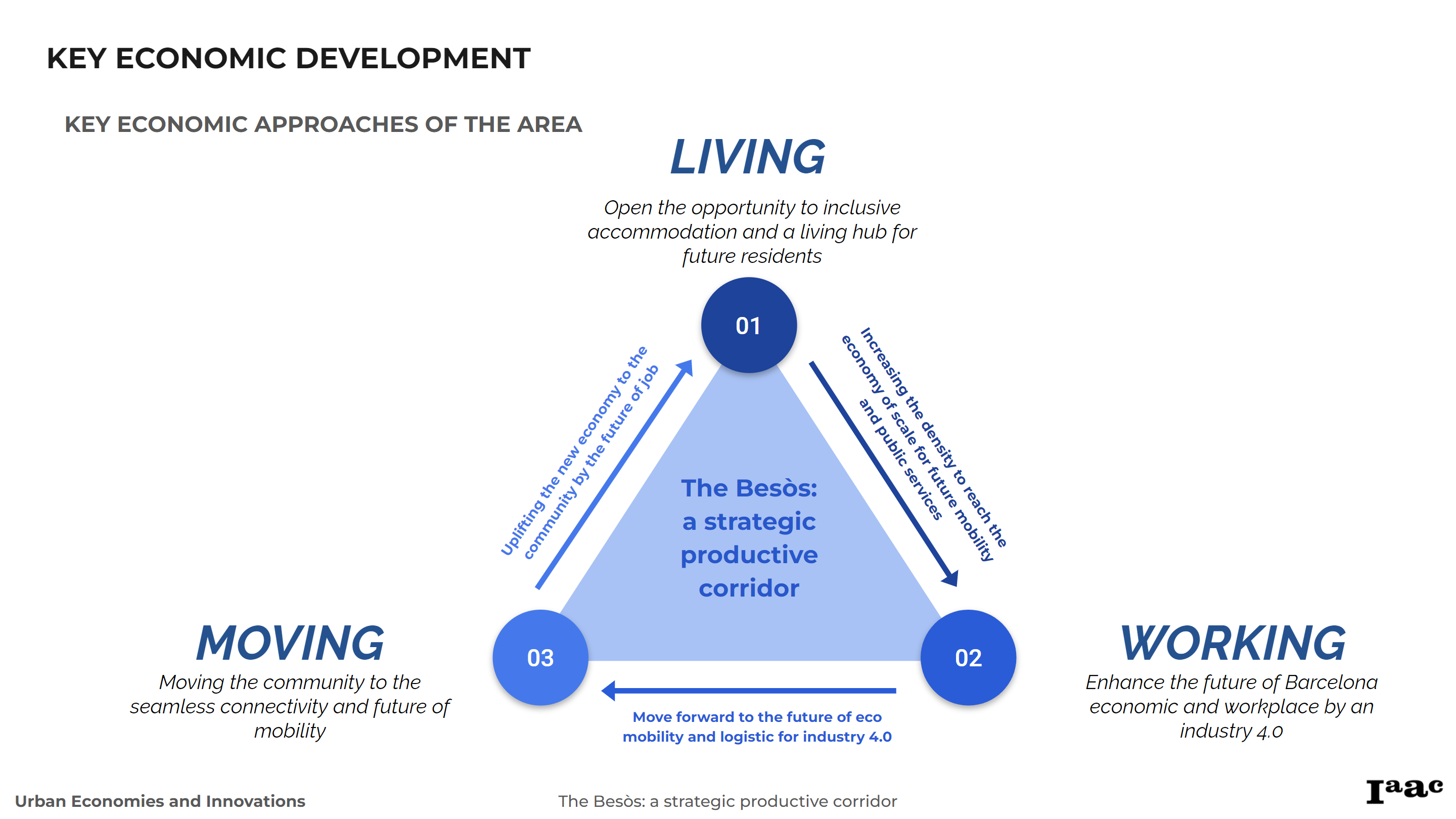
DEVELOPMENT ASPECTS

1. HOUSING
Emerging in 1929 with the construction of inexpensive houses known as Cases Barates, Bon Pastor evolved into a well-established community during the 1960s. Initially marginalized due to institutional neglect, this humble working-class neighborhood has overcome its challenging origins and transformed into an open, dynamic enclave with a forward-looking perspective.
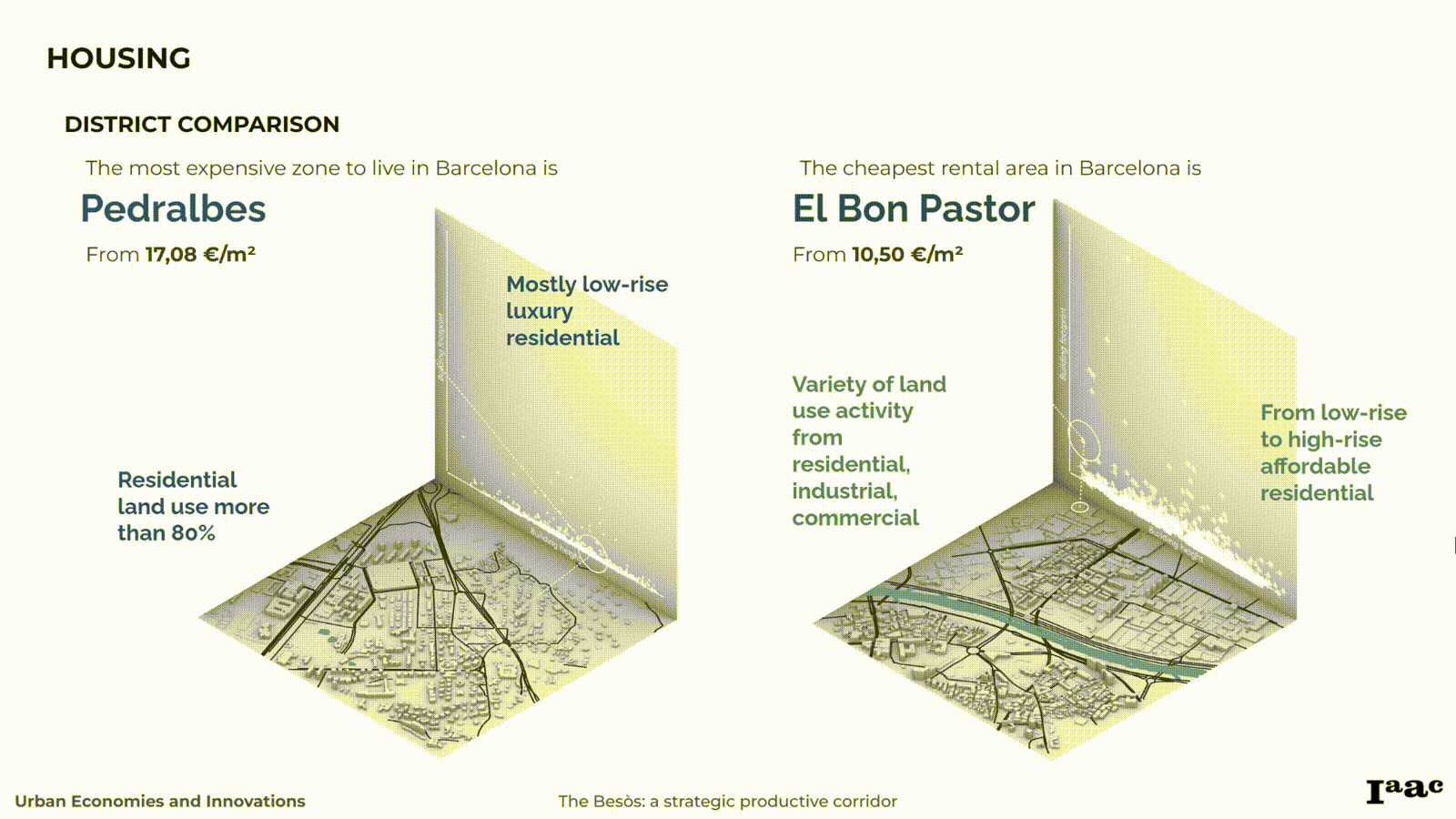
Bon Pastor, has a good reputation in term of affordable housing and the cheapest rental area in Barcelona compare to the others area, and the most expensive zone to live in is Pedralbes.
The struggle of Bon Pastor residents against development and gentrification has been a protracted one. Initially focused on Casas Baratas and the looming threat of urban renewal projects impacting cultural heritage and community traditions, attention has now shifted to prominent real estate developers and the looming spectre of speculation, privatization, and large-scale gentrification.
The momentum behind ConrenTramway’s development plans has continued to grow through 2021, marked by a doubling of property prices since the acquisition of the Mercedes-Benz factory in 2018 (Delmau Pujol, 2021). The fact that neighbouring areas, including La Sagrera, Plaza de las Glòries, 22@, Campus Diagonal-Besòs, and Santander Bridge, have also witnessed renewal processes leading to the displacement of long-term residents serves as tangible evidence of the detrimental impacts of these urban renewal initiatives.
For the project to proceed, the Ajuntament necessitates participatory zoning practices that involve residents in expressing their concerns. However, this approach raises concerns due to its resemblance to the “participatory” processes employed in the Casas Baratas neighbourhood, which ultimately left long-time residents feeling unheard and displaced.
Our approach is to continue developing the area with new affordable housing where there are still “Casas Baratas”. Some new buildings have already been constructed but there is still space to tackle one of Barcelona’s main problem that is few housing offer. The impact of new housing on a low-income neighbourhood can be complex and multifaceted, and it depends on various factors, including the type of housing, the scale of development, local policies, and community engagement. Here are some potential effects:
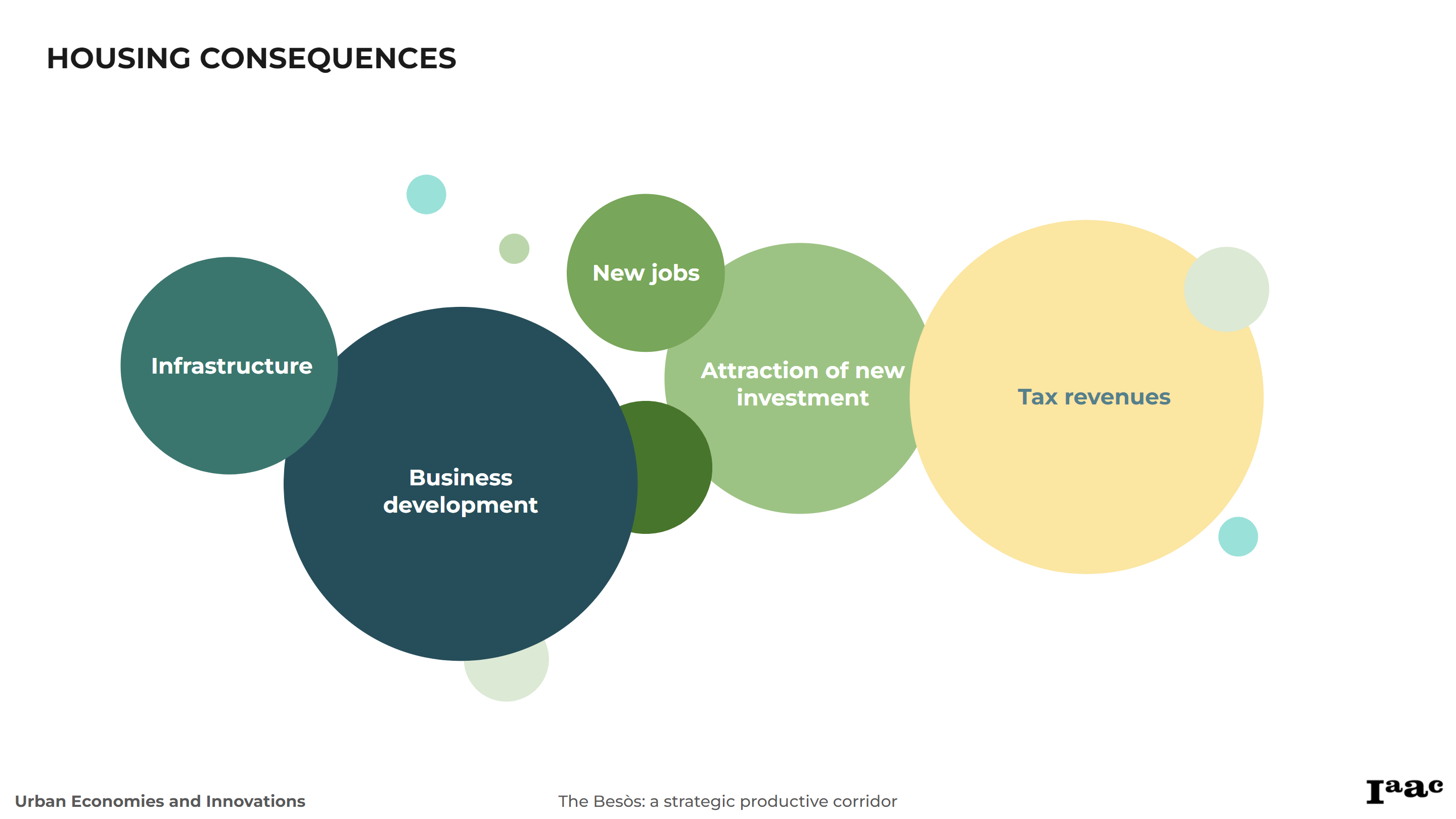
Challenges:
- Displacement of Existing Residents: The introduction of new housing developments can lead to the displacement of long-term residents, particularly those in lower-income brackets, as property values and rental costs rise.
- Rising Cost of Housing: New housing developments, especially those aimed at higher-income markets, can drive up the overall cost of living in the area, making it unaffordable for existing residents.
- Loss of Cultural Identity: New developments may not reflect the historical and cultural characteristics of El Bon Pastor, leading to a loss of the neighborhood’s unique identity.
- Infrastructure Strain: Increased population density can put a strain on existing infrastructure, including roads, public transportation, utilities, and social services.
- Zoning and Regulatory Hurdles: Changing zoning laws to allow for new housing can be a complex process, involving negotiations with city planners, residents, and developers.
2. INDUSTRY
El Bon Pastor is poised for an industrial renaissance. Currently anchored by traditional manufacturing, wholesale, and retail sectors, the neighbourhood has the potential to embrace a new era of innovation. This shift envisions the transformation of industrial spaces to accommodate emerging industries, including nanotechnology, intelligent mobility, robotics, circular economy, advanced manufacturing, agri-food, and data science/software.
In the realm of nanotechnology and advanced materials, El Bon Pastor could repurpose existing spaces into cutting-edge research and development centres.
Similarly, for intelligent mobility, the conversion of designated areas into testing grounds for innovative solutions could position El Bon Pastor as a Pioneer in the region.
The establishment of robotics laboratories and production facilities stands as another prospect, requiring supportive zoning regulations and incentives from the City Council to encourage workforce training.
For the circular economy, the repurposing of industrial spaces for recycling and upcycling initiatives aligns with sustainability goals.
Modernizing manufacturing through the integration of Industry 4.0 technologies is a strategic move.
In the agri-food sector, El Bon Pastor could reimagine industrial spaces as vertical farming facilities and hubs for food innovation.
Lastly, the repurposing of spaces into co-working hubs and innovation centres for data science and software industries could attract tech companies and start-ups.
The City Council’s crucial role encompasses incentivizing innovation, streamlining zoning regulations, investing in infrastructure, and forging educational partnerships. Through a strategic combination of visionary policies and a focus on emerging industries, El Bon Pastor has the potential to redefine its economic landscape and contribute to the city’s technological and sustainable progress.

Challenges:
- Integration with Legacy Systems: Older infrastructure may not seamlessly integrate with new Industry 4.0 technologies, requiring significant updates or replacements.
- Financial Constraints: The transition to Industry 4.0 can be costly, requiring substantial investment in technology, infrastructure, and training.
- Workforce Development: There is a need for skilled workers who are trained in new technologies. This necessitates workforce training and potential shifts in job profiles.
- Regulatory and Zoning Challenges: Implementation may require changes in zoning laws and compliance with new regulations related to Industry 4.0 technologies.
- Technological Adaptation: Adapting to rapidly evolving technologies in fields like nanotechnology, robotics, and data science can be challenging.
- Environmental and Aesthetic Concerns: Updating industrial areas to fit Industry 4.0 standards may raise environmental and aesthetic issues.
- Community Impact: There is a risk of gentrification and displacement of local residents due to rising property values and changes in the neighborhood’s character.
3. MOBILITY
The Challenge of Connectivity:
One of the major challenges in Bon Pastor has been its connectivity, both within the neighbourhood and with the rest of Barcelona. Despite being part of the bustling city, Bon Pastor has struggled with fragmented road hierarchies and disjointed cycle paths and pedestrian routes. The emphasis on motorized vehicles over pedestrian-friendly spaces has been a noticeable hurdle.
A Strategic Productive Corridor: The Besòs:
The Besòs corridor presents a unique opportunity. As a strategic productive corridor, it offers a blueprint for balancing road hierarchies and promoting sustainable transportation modes like cycling and walking. The proposed solution involves a three-tier road layout: main arteries for large vehicles supporting the industry, a distribution network for smaller vehicles, and ‘superblocks’ where walking and cycling take precedence.
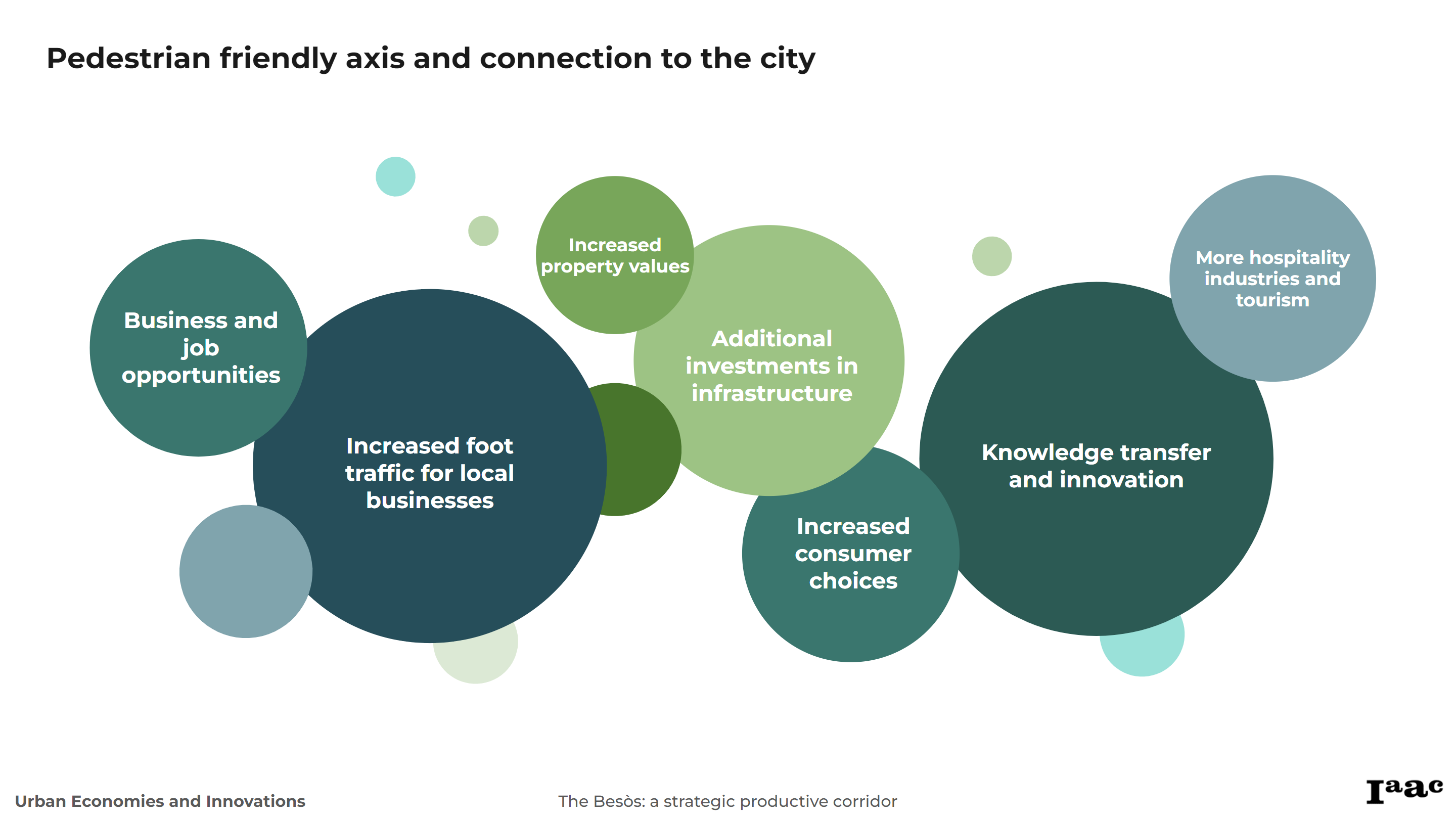
Challenges:
- Balancing Traffic Flow and Accessibility: Implementing a three-tier road layout requires careful planning to ensure efficient traffic flow for large vehicles while prioritizing pedestrian and cycle routes.
- Integrating with Existing Infrastructure: Modifying existing roads and infrastructure to accommodate the new hierarchy can be complex and costly.
- Community Acceptance and Participation: Gaining the support and understanding of local residents and businesses for the changes is crucial. Ensuring that the community’s needs and concerns are addressed is a key challenge.
- Environmental Impact: Ensuring that the changes do not adversely affect the local environment, particularly in terms of air quality and noise pollution.
- Safety Concerns: Ensuring the safety of all road users, especially in areas where different modes of transport interact, such as pedestrian crossings and bike lanes.
- Cost and Funding: Securing the necessary funding for the project and managing costs effectively throughout the implementation process.
- Displacement of Existing Residents: As the neighborhood becomes more accessible and potentially more desirable, there is a risk of displacing existing residents due to rising property values and gentrification.
ECONOMIC CONSEQUENCE
El Bon Pastor’s evolving industrial area promises a spectrum of economic benefits. Anticipated changes include job creation, increased property values, and investments in research and development. Diversification of the local economy and stimulation of innovation are also on the horizon.
As from delve deeper into this case study, the potential for replicating similar models in other urban settings becomes increasingly clear. The Bon Pastor story is a testament to the power of strategic urban planning in transforming not just the physical space but the socio-economic fabric of a community.
PLATFORM URBANISM
Platform urbanism stands as a transformative force in driving economic change within the Besòs productive corridor. This paradigm shift is exemplified through diverse applications, including platforms designed for affordable housing rentals and co-living spaces. These tools streamline property management, ensuring that housing is not only cost-effective but also fosters a sense of communal living. Simultaneously, the integration of platforms addressing eco-vehicle parking and pedestrian movement facilities plays a crucial role in shaping a more sustainable and accessible urban landscape. By optimizing transportation and enhancing walkability, these platforms contribute to a greener, more efficient urban ecosystem. Furthermore, the establishment of a regulatory sandbox and innovation testbed in Barcelona signifies a forward-thinking approach to fostering new ideas. This initiative provides a dedicated space for entrepreneurs and innovators to experiment with novel concepts, positioning the Besòs productive corridor as a hub for cutting-edge advancements and economic growth.

CONCLUSION
This transformation aligns El Bon Pastor competitively on the global stage, optimizing supply chains and fostering environmental sustainability. Improved facilities and amenities enhance resident quality of life, connected the community to the urban fabric through the new mobility axis, and connected the city back to the Besòs River again. Finally, the coexistence of industries is set to encourage collaboration and knowledge sharing, attracting and retaining skilled professionals, and fostering a dynamic and innovative community.
